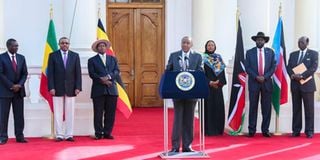Premium
Kenya in pole position to help unite Africa for peace, shared prosperity

President Uhuru Kenyatta, flanked by EAC Heads of State and Government, gives his statement after attending a consultative meeting on the Lapsset project at State house, Nairobi, on November 19, 2014.
The year 2021 unfolded as annus mirabilis – wonderful year – for Kenya’s diplomacy. In January, this lower-middle-income country took up its seat as one of the 10 non-permanent members of the powerful United Nations Security Council for a two-year term.
The country is also in the African Union Peace and Security Council (AUPSC), and held the council’s rotational chairmanship for the month of March.
President Uhuru Kenyatta chairs the Summit of the East African Community (EAC). And Kenya’s Dr Peter Mutuku Mathuki, a long-term Executive Director of the East African Business Council, is the incoming EAC Secretary-General.
The question remains: will Kenya leverage on its new diplomatic power to assert itself as a ‘regional power’, along the lines of South Africa in Southern Africa or Nigeria in West Africa, and breathe new life into the EAC?
A shy power, Kenya is often taken for granted by its neighbours and international partners, yet it contributes significantly to regional prosperity and stability.
Now at the helm of the EAC Heads of State Summit and the Secretariat, the stars are aligned for Kenya and the regional group. The EAC had a bumpy start. A decade after its formation in 1967, it collapsed in 1977. However, its members have doubled from three in July 2000 – when it was revived – to six today: Burundi, Kenya, Rwanda, South Sudan Tanzania and Uganda. Its potential frontiers of expansion include the Democratic Republic of the Congo (DRC) , Malawi, Somalia, Sudan, Zambia and even Ethiopia.
Monetary union
A revamped EAC, with its capital in Arusha, Tanzania, is envisioned as a precursor to the establishment of East African Federation as a single sovereign state. Already, it has established the East African Court of Justice and the East African Legislative Assembly (EALA).
In 2010, EAC launched its common market for goods, labour and capital. A protocol signed in 2013 outlined the bloc’s plans to launch a monetary union in about a decade. Citizens of member states can sing a common anthem and travel on the bloc’s passport. A team formed in September 2018 has been drafting a regional constitution.
EAC, the Economic Community of West African States (Ecowas) and Southern African Development Community (SADC) are three of the most developed and effective blocs.
With an area covering about 2.5 million square kilometres and with more than 173,583,000 people, it has the ninth-largest population in the world, a $163 billion-strong economy and Gross Domestic Product of $941 billion.
Overlapping memberships
Yet it faces a real risk of collapsing under its own weight as one of the more than 500 inter-governmental organisations modern Africa has created.
It also faces the problem of overlapping multiple memberships, with 89 per cent of the 54 African countries being members of more than one bloc. The DRC belongs to five blocs, Burundi and Kenya four and only six are members of one bloc alone.
This overlap reflects divergence of visions, strategies and philosophies of the founding fathers of modern Africa.
Ghana’s Kwame Nkrumah declared that ‘Africa must unite’ and immediately form a United States of Africa as an antidote to colonial balkanisation, instability and poverty. Tanzania’s Mwalimu Julius Nyerere, while sharing Nkrumah’s thesis, proposed a gradual road to unity, with regional organisations as building blocks to continental unity.
Upon replacing the Organisation of African Unity, the African Union has moved to curb the problem of proliferation of regional organisations. It has recognised only eight building blocks of the African Economic Community (AEC), which was established by the 1991 Abuja Treaty.
Scholars and national policy makers have recognised the heavy cost of unbridled expansion of regional blocs. Their multiple and confusing memberships have slowed down integration and engendered low attendance to meetings, inadequate payment of contributions, duplication and competition over activities, large resource costs and other financial constraints. They have also contributed to what has been described as the “the Spaghetti Bowl Effect – a slowdown in trade relations as Free Trade Agreements (FTAs) between them increase.
Kenya needs to pull itself and the bloc out of the multiple membership conundrum and foster coordination and integration across the region.
Past attempts to regroup the blocs have failed. During the July 2007 Summit in Accra, Ghana, the AU adopted a Protocol on Relations between the African Union and the regional economic communities (RECs), which sought to harmonise the policies of RECs to ensure compliance with the Abuja Treaty and the Lagos Plan of Action.
Against this backdrop, in 2008 the EAC held talks with SADC and Comesa, leading to the creation of the African Free Trade Zone (AFTZ). In May 2012, AFTZ was extended to include Ecowas, ECCAS and AMU, precursor to the African Continental Free Trade Area (AfCFTA).
Kenya has a partner in Tanzania, where President Samia Suluhu Hassan has repositioned the private sector as the engine for growth, formed of an Investment ministry and cautioned the Tanzania Revenue Authority against high-handed clampdown on the private sector over taxes.





